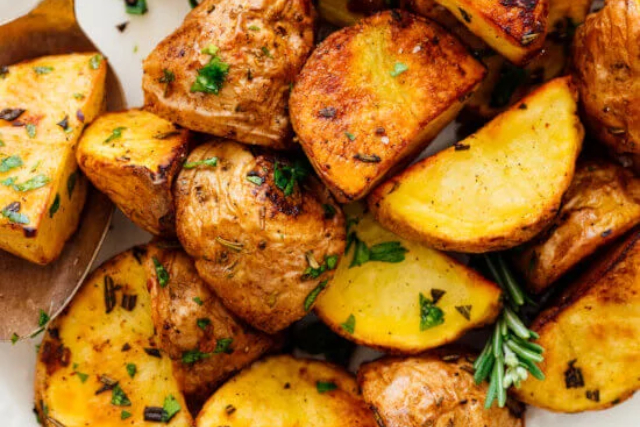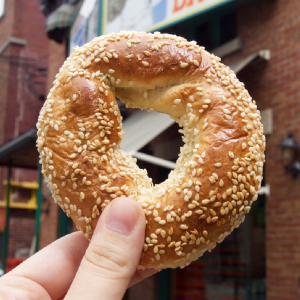I’ll bet you didn’t know that Baking Soda has many more potential uses in the kitchen than leavening, cleaning and deodorizing. And it’s about time we looked into some applications usually employed only by the most advanced pro and home cooks…
 Perfect, Golden Roasted Potatoes: Get ’em every time with the baking soda trick!
Perfect, Golden Roasted Potatoes: Get ’em every time with the baking soda trick!
A little history
Baking Soda (AKA – sodium bicarbonate) is one half of the tag team that makes up Baking Powder. The other half is a dry acid – tartaric or citric – which ‘activates’ the soda, generating bubbles of CO2. Those bubbles raise your non-yeast cakes, dumplings and related creations.
But there’s much more to baking soda than that. Would you believe it was first manufactured commercially in the US in 1846? Before that, many cooks used briskly-beaten eggs to leaven their cakes. With varying degrees of success.
“Naturally occurring forms of baking soda, such as natron, have been used for various tasks by human civilizations for millennia,” Daily Meal reveals. “In Ancient Egypt, natron was used for the creation of glass, as a medicine, and in the mummification process, as reported in Revue d’Histoire de la Pharmacie. Baking soda is still employed for a variety of uses, including both cleaning and deodorizing.”
Sharing ‘secrets’…
Browning Bread crusts
Ever wondered how they get bagels to brown up so deeply and deliciously while keeping the interior so soft and chewy? It’s all in the alkalai.
Commercial bakers boil the unbaked bagels in an lye-dosed water bath. “The Journal of Agricultural and Food Chemistry highlights that alkaline conditions — lye has a pH level somewhere between 13 and 14 — speed up the Maillard [browning] reaction, the complex process wherein proteins and sugars are altered by heat, resulting in flavors, smells, and other phenomena such as browning,” Daily Meal explains.
Baking soda has a pH of just 8, one tick outside the acidic zone. But adding it to the boiling water – instead of toxic, hazardous lye – can achieve the same enhanced browning and earthy crust flavour.
De-gassing beans
Many folks shun beans because they (the diners) suffer embarrassing gas attacks after eating them. That’s a shame, because beans are one of the leading sources of plant protein and fibre.
Soaking dry beans in water containing baking soda is said to help break down break down oligosaccharides, a family of substances plentiful in all beans =, which aren’t easily digestible by humans. That’s where the intestinal issues causing gas arise.
Alkalai water also helps beans’ pectin molecules allowing them to soften faster when cooking. Adding just a teaspoon of baking soda to the cooking water can cut their cooking time by as much as half!
Perfect Roast Potatoes
Love that yummy, umami, crispy crust you get on restaurant roasted potatoes? You can get it at home by adding baking soda to the cooking water when you par-boil your spuds.
Once again, the soda is breaking down pectin – in the spuds’ surface, where the fat you brush them with before baking reacts to form that sumptuous, golden crust. The process also helps seal in moisture, so your roast spuds come out steamy, fluffy and tender inside.
Tame your Tomato Sauce
I often find my homemade tomato sauce is too acidic tasting. My favourite culinary school prof told me he always adds a teaspoonful of sugar to his, to balance out the flavour. But that also adds a sweetness that doesn’t necessarily go well with the herbs and spices you want to add.
Instead, try adding a punch or two of baking powder. Remember, it’s alkaline, so it will neutralize an equal amount of acid. Add it carefully, in small amounts, tasting after each addition until you reach the acid level you desire.
My take
I’ve already tried the sauce-taming technique. And I can report that it works beautifully. You get a smooth flavour that’s still bright and fruity, and everything you want from a tomato – especially if you’re using fresh ones!
Years ago, a BFF [at the time] and I stayed up all night to make authentic Montreal-style bagels. And it was amazing to see them puff up almost instantly in the boiling water. And the baking soda in that water imparted the beautiful crust the recipe promised.
I’ve tried the bean de-gassing technique in the past. But I’ve never been able to really test it. Neither I not Sister Erin have the ‘out-gassing’ problem. I will say this – the beans do cook faster with just a little baking n soda in the cooking water! I think that tip is worth its weight in gold.
Anyway… I enthusiastically recommend that you add these baking soda trips and tricks to your culinary knowledge base. You’ll be glad you did!
~ Maggie J.

